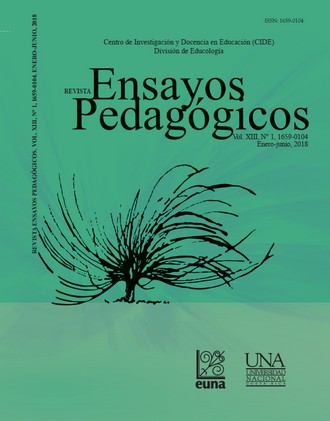Effect of the Program "Un paso activo" in the Movement Habits of Primary School Students
DOI:
https://doi.org/10.15359/rep.13-1.3Keywords:
intervention, behavior change, attitude, physical activityAbstract
The purpose of this article was to evaluate the effect of the program “Un Paso Activo” on students’ physical activity of elementary students. Subjects: 69 third-grade students from a public urban school in the central canton of San José, of which 34 belonged to the experimental group (16 boys and 18 girls) and 35 to the control group (15 boys and 16 girls), with average ages Of 9.2 years, took part in the study. The intervention was led by the project coordinator and the institution’s physical education teacher, who provided the experimental group with a socio-constructivist approach to the lessons of Education given by the Ministry of Education in organizing the lessons of Physical Education, using the Active Step program as a methodological tool. Study Design: A quasiexperimental design was used over 4 months. Results: Boys and girls in the experimental group had a significant increase in knowledge, and in the time reported in physical activity through the directed report (<.05). Conclusions: The pedagogical strategy given by MEP improved the time spent on physical activity and the state of change of participants in the experimental group, especially in girls. This study proved to be practical and showed that it could be easily incorporated into the educational context.
References
Álvarez, C. (2016). Efectividad del programa ecológico “Saltando por su salud” en la promoción de la actividad física y la auto-eficacia en niños y niñas escolares de tercer grado. Revista Ensayos pedagógicos, 11(1), 147-169.
Bandura, A. (1977). Self-efficacy: The exercise of control. New York: Freeman.
Biddle, S. J. H., O’Connell, S., y Braithwaite, R. E. (2011). Sedentary behaviour interventions in young people: A meta-analysis. British Journal of Sports Medicine, 45(11), 937–942.
Bronfenbrenner, U. (1979). The Ecology of Human Development: Experiments by Nature and Design. Harvard University Press,Cambridge, MA.
Camacho-Min, M., Nicole M., LaVoi Daheia J, y Barr-Anderson. (2011). Interventions to promote physical activity among young and adolescent girls: a systematic review. Health Education Research, 26(6),1025-49.
Center for Disease Control and Prevention [CDC]. (2013). Make a Difference at Your School. Recuperado de http://digitalcommons.hsc.unt.edu/cgi
Cox, M., Schofield, G., y Kolt, G. S. (2010). Responsibility for children’s physical activity: parental, child, and teacher perspectives. J. Sci. Med. Sport, 13, 46–52.
Demetrious, Y., y Höner, O. (2012). Physical activity interventions in the school setting: A systematic review. Psychology of Sport and Exercise, 13(2), 186–196.
Dudley, D., Okely, A., Pearson, P., y Cotton,W., (2011). A systematic review of the effectiveness of physical education and school sport interventions targeting physical activity, movement skills and enjoyment of physical activity. Eur. Phys. Educ. Rev, 17, 353–378.
Greaves, C., Sheppard, K., Abraham, C., Hardeman, W., Roden, M., Evans, P., y Schwarz, P. (2011). Systematic review of reviews of intervention components associated with increased effectiveness in dietary and physical activity interventions. Bio-Med, 11, 2-12.
Gorely, T, y Bruce, D. (2000). A 6-month investigation of exercise adoption from the contemplation stage of the transtheoretical model. Psychology of Sport and Exercise,1(2), 89-101.
Haas, S y Nigg C. (2008). Construct validation of the stages of change with strenuous, moderate, and mild physical activity and sedentary behaviour among children. Journal of Science and Medicine in Sport, 12, 86–591.
Harrell, S., Gansky, S., McMurray, R., Frauman, A., y Bradley, C. (1998). School based interventions improve heart health in children with multiple cardiovascular disease risk factors. Pediatrics, 102, 371-380.
Hynynena, S.,M. M. van Stralenb, F. F. Sniehottac, V. Araújo-Soaresc, W. Hardemand, M. J. M. Chinapawe, T. Vasankarif y. Hankonena. (2015). A systematic review of school based interventions targeting physical activity and sedentary behaviour among older Adolescents. International Review Of Sport And Exercise Psychology, 9(1), 22–44. http://dx.doi.org/10.1080/1750984X.2015.1081706
Janssen, I., y LeBlanc, A. G. (2010). Review systematic review of the health benefits of physical activity and fitness in school-aged children and youth. International Journal of Behavioral Nutrition and Physical Activity, 7(40), 1–16.
Janz K. F., Burns T. L., y Levy, S. M. (2005). Tracking of Activity and Sedentary Behaviors in Childhood: The Iowa Bone Development Study. Am J Prev Med, 29(3), 171–178.
Kahn, E. B., Ramsey, L. T., Brownson, R. C., Heath, G. W., Howze, E. H., Powell, K. E., Stone, E. J., Rajab, M. W., y Corso, P. (2002). The effectiveness of interventions to increase physical activity: a systematic review. Am J Prev Med, 22, 73–107.
Kowalski, K., Crocker, P., y Faulkner, R. (1997). Validation of the Physical Activity Questionnaire for Older Children. Pediatric Exercise Science, 174-186.
Lox, C., Martín, K. y Petruzzello, S. (2006). The Psychology of Exercise. Arizona: HHP.
Lubans, D. R., Foster, C., y Biddle, S. J. H. (2008). A reviewofmediators of behavior in interventions to promote physical activity among children and adolescents. Prev. Med, 47, 463–470. 20.
McKenzie, T. L., Nader, P. R., Strikmiller, P. K., Yang, M. (1996). School physical education: Effectof the child and adolescent trial for cardiovascular health. Prev.Med, 25, 423–431.
Marcus, B. y Forsyth, L.(2003). Motivating People to be Physical Active. Champaign, IL: Human Kinetics.
MEP. (2013). Programas de Estudio de Educación Física. San José, Costa Rica: Autor.
Michie, S., y Abraham, C. (2004). Interventions to change health behaviours: evidencebased or evidence-inspired? Psychol. Health, 19, 29–49.
Nader, P., Sellers, D., Johnson, C., Perry ,C., Stone, E., Cook, K., Bebchuk, J, and Luepker, R. (1996). The effect of adult participation in a school-based family intervention to improve Children's diet and physical activity: the Child and Adolescent Trial for Cardiovascular Health. Revista end línea Pub-Med, 25(4),455-64. Recuperado de https://www.ncbi.nlm.nih.gov/pubmed/8818068
Peters, L. W., Kok, G., Ten Dam, G., Buijs, G. J., y Paulussen, T. (2009). Effective elements of school health promotion across behavioral domains: A systematic review of reviews. BMC Public Health, 9(1), 182–196.
Prochaska, J. y DiClemente, C. (1983). The Transtheoretical Model. Recuperado de http://ocw.unican.es/ciencias-de-la-salud/promocion-de-la-salud/material-de-clase/tema-3.-el-modelo-transteorico/skinless_view
Safron, D, Schulenberg, J y Bachman, J (2001). Part-time work and hurried adolescence: The links among work intensity, social activities, health behaviors, and substance use. Journal of Health and Social Behavior, 42, 425–449. 10.2307.3090188. [PubMed].
Sallis, J., McKenzie, T. L., Alcaraz, J., Kolody, B., Faucette, N., y Hovell, M. (1997). The effects of a 2-year physical education program (SPARK) on physical activity and fitness in in elementary school students. Sports, Play and Active Recreation for Kids. Am J Public Health, 87(8), 1328-34.
Salmon, J., Booth, M. L., Phongsavan, P., Murphy, N., y Timperio, A. (2007). Promoting Physical Activity Participation among Children and Adolescents. Epidemiol Rev, 29, 144–159. 23.
Salmon, J., y Timperio, A. (2007). Prevalence, trends and environmental influences on child and youth physical activity. Med Sport Sci, 50, 183-199. 15.
Thorp, A., Owen, N., Neuhaus, M, y Dunstan, D. (2011). Sedentary behaviors and subsequent health outcomes in adults a systematic review of longitudinal studies. American Journal of Preventive Medicine, 41(2), 207-215.
Timperio, A., Salmon, J., y Ball, K. (2004). Evidence-based strategies to promote physical activity among children, adolescents and young adults: review and update. Journal of Science and Medicine in Sport, 7(Suppl 1), 20–29.
Van Sluijs, E., Van Poppel, M., Stalman, W., y Van Mechelen, W. (2004). Feasibility and acceptability of a physical activity promotion program in general practice. Family Practice, 21, 429–436.
Walter, H., Hofman, A., Connelly, P., Barrett, L, y Kost, K. (1985). Primary prevention of chronic disease in childhood: changes in risk factors after one year of intervention. Am J Epidemiol, 122, 772-81.
Ward, D., Saunders, R., y Pate, R. (2007). Physical Activity Interventions in Children and Adolescents. Champaign, Il: Human Kinetics Publishers.
Weston, A., Petosa, R., y Pate, R. (1997). Validation of an instrument for measurement for physical activity in youth. Medicine and Science in Sport and Exercise, 29, 138-143.
WHO. (2010). Recomendaciones mundiales sobre actividad física. Ginebra, Suiza: OMS.
Wilmot, E. G., Edwardson., C. L., Achana, F. A., Davies, M. J., Gorely, T., Gray, L. J, y Biddle, S. J. H. (2012). Sedentary time in adults and the association with diabetes, cardiovascular disease and death: Systematic review and meta-analysis. Diabetologia, 55, 2895–2905.
Downloads
Published
How to Cite
Issue
Section
License
Ensayos Pedagógicos is subscribed to the Attribution-NonCommertial-NoDerivatives 4.0 International Creative Commons Licence, which allows both authors and readers to freely download, store, copy, and distribute the final approved publisehd version of the manuscript (post-print) as long as this is done without commercial purposes, no derivative works are generated, and the source and author are mentioned. As well, Ensayos Pedagógicos declares that authors will remain the rightful owners of the copyrights of their work in perpetuity.







